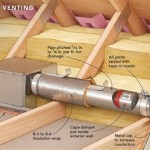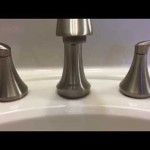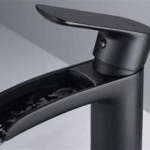How To Seal Pipes Under Bathroom Sink
The plumbing under a bathroom sink, while often overlooked, is a critical component of a functional bathroom. Leaks in this area can lead to significant water damage, fostering mold growth and potentially affecting the structural integrity of the surrounding cabinetry and flooring. Understanding how to properly seal these pipes is essential for both preventing these problems and maintaining the value of the property. This article provides a detailed guide on identifying leaks, selecting appropriate sealant materials, and executing the sealing process effectively.
The complexity of sealing pipes under a bathroom sink stems from the various connections involved. These often include connections between the sink drain and the tailpiece, the tailpiece and the P-trap, the P-trap and the drainpipe extending into the wall, and potentially connections to supply lines for the faucet. Each of these junctions is a potential weak point where leaks can originate. Therefore, a thorough understanding of these connections and the appropriate sealing techniques for each is paramount.
Before initiating any sealing procedures, a systematic evaluation of the existing plumbing is necessary. This evaluation should pinpoint the exact source of the leak and assess the general condition of the pipes and fittings. Identifying the types of materials involved, such as PVC, copper, or chrome-plated brass, is also crucial as it will influence the choice of sealant and tools used. Ignoring the material composition can lead to incompatibility issues and potential damage to the pipes.
Identifying the Source of the Leak
The first step in sealing pipes under the bathroom sink is accurately identifying the leak's origin. This may seem obvious, but pinpointing the exact point of leakage can sometimes be difficult. Start by thoroughly drying the area under the sink with a clean cloth or paper towels. Once the area is dry, carefully monitor each connection while running water in the sink. Pay close attention to the threaded connections and slip joints, as these are the most common points of failure.
A flashlight can be a valuable tool in this process, allowing for a closer examination of the pipes and connections. Look for visible signs of water droplets forming or running down the pipes. Also, inspect for mineral deposits or corrosion around the joints, which can indicate previous or ongoing leaks. Run the water for a prolonged period, including filling the sink and then draining it, as leaks may only become apparent under specific conditions. If necessary, use a small mirror to inspect the back of pipes that are difficult to see directly.
If the leak is not immediately apparent, wrap small pieces of dry paper towel around each connection. After running the water, check the paper towels to see which one has become wet, thus indicating the source of the leak. This method can be particularly useful for slow or intermittent leaks. Ensure that all connections are inspected, including those involving the faucet supply lines, as these can sometimes drip onto the drain pipes, misleading the diagnosis.
Once the source of the leak is identified, note the type of connection. Is it a compression fitting, a threaded connection, or a slip joint? This information is crucial for determining the appropriate repair method and the necessary materials. Also, assess the condition of the existing components. Are they corroded, damaged, or simply loose? This assessment will determine whether a simple tightening or resealing is sufficient, or if replacement of the component is necessary.
Selecting the Appropriate Sealant and Materials
Choosing the correct sealant and other materials is crucial for achieving a durable and effective seal. The type of pipe material, the nature of the connection, and the severity of the leak all influence this decision. Several options are available, each with its own advantages and disadvantages. A general understanding of these options is essential for making an informed choice.
For threaded connections, Teflon tape (also known as plumber's tape) is a standard choice. This thin, non-adhesive tape is wrapped around the threads of the male fitting before it is connected to the female fitting. The tape fills the gaps between the threads, creating a watertight seal. Teflon tape is relatively inexpensive and easy to apply, making it a popular choice for many plumbing applications. However, it is important to apply the tape correctly, wrapping it in the direction of the threads to avoid unraveling during tightening.
Pipe joint compound (also known as pipe dope or thread sealant) is another option for sealing threaded connections. This compound is applied to the threads of the male fitting and acts as both a lubricant and a sealant. Pipe joint compound can be more effective than Teflon tape in certain situations, particularly when dealing with older or damaged threads. However, it can be messier to apply and may require more cleanup. Some pipe joint compounds are specifically formulated for use with certain types of pipes, so it's important to choose the right one for the job.
For slip joint connections, rubber or plastic washers are typically used to create the seal. These washers compress against the pipe when the slip joint nut is tightened, forming a watertight barrier. Over time, these washers can become brittle or deformed, leading to leaks. In such cases, replacing the washers is usually the best solution. When replacing slip joint washers, it's important to choose the correct size and type to ensure a proper fit and seal. Some washers are tapered, while others are flat, and using the wrong type can prevent a tight seal.
Silicone caulk can be used to seal small gaps or cracks in pipes or fittings. However, it is generally not recommended for sealing threaded connections or slip joints, as it can be difficult to remove and may not provide a reliable seal over time. Silicone caulk is best suited for sealing around the base of the faucet or where the drainpipe enters the wall, preventing water from seeping behind the sink or into the wall cavity. Choose a silicone caulk that is specifically formulated for plumbing applications and is resistant to mold and mildew.
In some cases, epoxy putty may be used to repair damaged pipes or fittings. This two-part putty is mixed together and applied to the damaged area, where it hardens to form a permanent seal. Epoxy putty can be effective for repairing small cracks or holes in pipes, but it is not a substitute for replacing a severely damaged component. When using epoxy putty, follow the manufacturer's instructions carefully and allow it to cure completely before exposing it to water.
Step-by-Step Sealing Procedure
After identifying the leak and selecting the appropriate materials, the next step is to execute the sealing procedure. This requires careful preparation, meticulous application of the sealant, and thorough testing to ensure the leak is resolved. The steps outlined below provide a comprehensive guide to sealing pipes under a bathroom sink.
First, shut off the water supply to the faucet. This is typically done by turning off the shut-off valves located under the sink. If shut-off valves are not present or are malfunctioning, the main water supply to the house may need to be turned off. Before proceeding, test the faucet to ensure that the water is completely shut off. Place a bucket or towels under the pipes to catch any remaining water.
Next, disassemble the leaking connection. For threaded connections, use a wrench to loosen and remove the fitting. For slip joint connections, loosen the slip joint nut and slide the fitting apart. Carefully inspect the threads or the slip joint washer for damage or wear. If the threads are corroded or the washer is cracked or deformed, replace the component.
If using Teflon tape on a threaded connection, clean the threads of the male fitting with a wire brush to remove any old sealant or debris. Wrap the Teflon tape around the threads in the direction of the threads, overlapping each layer slightly. Apply several layers of tape to ensure a good seal. If using pipe joint compound, clean the threads and apply the compound liberally to the threads of the male fitting.
Reassemble the connection, tightening the fittings securely. For threaded connections, use a wrench to tighten the fitting until it is snug. Avoid overtightening, as this can damage the threads. For slip joint connections, tighten the slip joint nut until it is snug, but not so tight that it cracks the nut or the pipe. Ensure that the washer is properly seated and compressed.
After reassembling the connection, turn the water supply back on slowly. Carefully inspect the connection for any signs of leaks. If a leak is present, tighten the fitting slightly or disassemble the connection and reapply the sealant. Continue to monitor the connection for several hours to ensure that the seal is holding. Pay close attention to the area as water pressure builds up in the pipes. A slow leak may not be immediately apparent and may take some time to manifest.
If silicone caulk is being used, apply it sparingly to the area around the connection, smoothing it out with a finger or a small tool. Allow the caulk to dry completely before exposing it to water. It’s crucial to apply the caulk only to areas where it’s needed, avoiding covering up any potential leak points that need future inspection. Make sure the surface is clean and dry before applying the caulk for optimal adhesion.
Finally, conduct a thorough test of the entire plumbing system under the sink. Run the water in the sink for an extended period, including filling the sink and then draining it. Check all connections for leaks. Also, inspect the faucet and supply lines for any signs of drips or leaks. If any leaks are found, repeat the sealing procedure as necessary. A meticulous and patient approach is often required to achieve a completely leak-free plumbing system.

Bathroom Sink Drain Leaking Around Threads Premier Plumbing Inc

What To Do If You Have A Leaking Pipe Under The Bathroom Sink Air Assurance

Common Sink Leaks You Could Probably Fix Yourself

Fix A Leaking Pipe Under Bathroom Sink Plumbers Talklocal Blog Talk Local

Bathroom Sink Drain Leaking Around Threads Premier Plumbing Inc

How To Fix Bathroom Sink Drain Leaks Underneath Gasket Threads Solved

Trap Leaking Under Bathroom Vanity Doityourself Com Community Forums

Bathroom Sink Drain Leak Not Sure How To Fix Doityourself Com Community Forums

How To Fix Pipework A Tap Faucet Leaking Under The Sink

Leaking Sink Tailpieces Ehow
Related Posts







